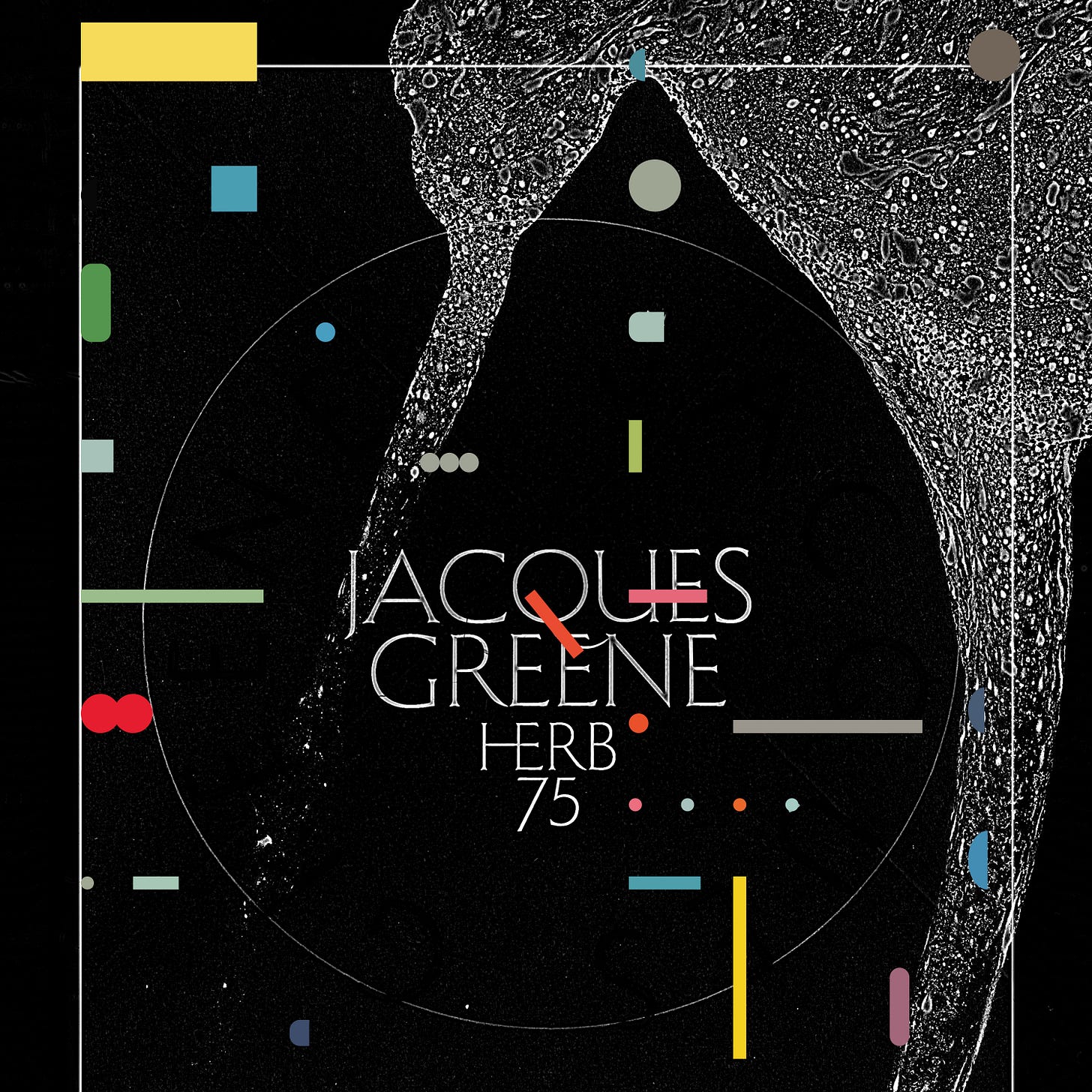Herb Sundays 75: Jacques Greene
Montréal's dance hero reveals a personal comfort playlist of female-led "hoodie up" tunes.
Herb Sundays 75: Jacques Greene (Apple, Spotify, Tidal). Art by Michael Cina.
“This playlist has existed in some form privately for me for 3 or 4 years now. It feels almost odd sharing it publicly. My friend put me onto Luscious Jackson and Cranes and it triggered a deep dive into this vague zone of loose, narcotic female-led alternative music from the early/ mid 90s.
It’s become an absolute clutch hangover at the airport, noise canceling on, hoodie up safe space. S-tier sunday afternoon music to slowly make dinner to.” - Jacques Greene
Jacques Greene is the artist name of Montréal-born DJ and producer Philippe Aubin-Dionne (you may call him Phil, but I’ll use his artist name from here on out). Known for his emotive live sets and productions, he’s also a deft hand at the remix too, retooling artists like Radiohead, Flume, MorMor, and Ghostly roster fave, Kllo. As a (former) graphic designer and clotheshorse, Greene has expanded his collaborations to include fashion (Givenchy, designer Rad Hourani) and art institutions including London’s Tate Modern.
Greene is an affable guy and can take a ribbing, IRL, and on socials. He’s sincere about his art but not so self-serious he can’t have a laugh. When in Montréal a number of years ago, Greene and fellow producer/DJ and best bud Martyn Bootyspoon (who has a devilish new record out) took me to a natural wine bar (the first time I heard that expression) which I didn’t know included shots cut in between each glass. I remain afraid of this Provence and its people.
I tried in earnest to sign Greene in the early '10s but it was for naught (I'll blame the manager of course), however, he's been in more than capable hands at the venerable LuckyMe label, and his albums, Feel Infinite (2017) and Dawn Chorus (2019), both with sleeves designed by the immaculate Hassan Rahim, have become contemporary staples, and have generated a loyal fanbase.
Greene’s productions move smoothly like machined parts gliding on Swiss ball bearings, but he employs enough grit and personality into the positive tropes of the genres he inhabits. As Detroit Techno and its many subvariants have reached the 40+ year mark, it’s refreshing to hear all the familiar innovations being available for fair use: The chopped breakbeat, the searing 303 acid line, and the pitched-up rave vocal, all find root in Greene’s yarn.
When Phil shared his mix with me he acted as if it was this huge reveal, but I assured him this was not anything to worry about. The mix is characteristically elegant and diffuse, digging into the emotive territory mined by earlier pioneers in post-rock, shoegaze, and downtempo such as 4AD’s Lush and Pale Saints, Cranes, and lesser-celebrated American acts such as Love Spirals Downwards and Drop Nineteens who all serve breakbeats atop jangle guitars to gauzy emotive delight.
In Greene’s bio, I noticed it says he is a House and R&B producer which surprised me for a moment. Not that I disagree (vocalists Katy B and Tinashe, plus post-R&B like How To Dress Well all have sung on Greene tunes) but that I never clocked it completely. I DJ’ed at Bar Datcha in Montreal later that aforementioned weekend and snuck in Phil's remix of Frank Ocean’s "White Ferrari" without having really previewed it and was shocked by its efficacy. Phil's music infuses a lot of sensuality that his peers lack, it’s romantic stuff.
In his RBMA interview with the incomparable Lauren Martin, he briefly asides about his love of pop, and also references Timbaland and The Neptunes as key influences. This made sense as Greene’s formative years saw the potential of hip-hop radio move past samples and into the metallic chromatic charms of the Korg Triton synth, all comic book exclamations and pop sincerity rigged up with explosives.
In his best works, it’s the impressionistic memory of fun that you’re seizing on. It’s Greene’s ‘half-remembered’ thing which makes his best works so evocative. Greene’s tunes are never about “the riff” but the machinations of all these things working together, just add nighttime and friends.
I wanted to recapture what it was that made me a fan of Greene’s in the first place and I often visit interviews and podcasts to understand artists on their own terms, beyond the press releases or accolades.
Greene’s 2021 RA Exchange interview was telling. You can hear the fragility in his voice, which reminded me of my own feelings at the time (we both live with frontline healthcare workers). But you also can sense that he was rebuilding himself, regenerating new paths by digging deeper. His original influences like filmmaker Wong Kar-wai were revisited, and the spinning emotions that helped him understand why art was important in the first place helped affirm his connection to humanity.
Greene refers to his younger self as a “very emotional receptacle for culture” and I’m guessing these High School Feelings (HSF) are what still drive his aims. For myself, I recently realized it maybe isn’t the past that I’ve been seeking, but the emotional connection to things. Herb Sundays is a forced effort to “dig in” on artists I admire in some capacity, and by spending a week in their ambient presence, I find my passion for their work increases.
The common goal to dunk on all things is rooted in protectionism and a fear of being duped. High School Feelings give us an open-hearted ability to sniff out what’s good, which we can dissect later. HSFs also remind us to go deep and to enjoy being a fan of things.
From the field.
Phil’s remix of Frank Ocean’s “White Ferrari”
Deforrest Brown Jr’s megamix of Drexciya for Carhartt Work In Progress.





